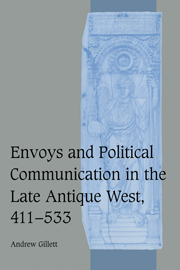Book contents
- Frontmatter
- Contents
- List of tables
- Preface
- List of abbreviations
- Chronological table
- Maps
- 1 EMBASSIES AND POLITICAL COMMUNICATION IN THE POST-IMPERIAL WEST
- 2 THE PROVINCIAL VIEW OF HYDATIUS
- 3 THE HERO AS ENVOY: SIDONIUS APOLLINARIS' PANEGYRIC ON AVITUS
- 4 THE SAINT AS ENVOY: FIFTH- AND SIXTH-CENTURY LATIN BISHOPS' LIVES
- 5 CASSIODORUS AND SENARIUS
- 6 NEGOTIUM AGENDUM
- CONCLUSION
- Appendix I Chronology of Constantius, Vita Germani
- Appendix II Chronology of the life of Epiphanius of Pavia
- Appendix III Senarius' Letters of Appointment: Cassiodorus, Variae IV, 3 and 4
- Appendix IV The text of Senarius' Epitaph
- Note on editions, commentaries, and translations of major sources
- Bibliography
- Index
- Cambridge Studies in Medieval Life and Thought Fourth series
6 - NEGOTIUM AGENDUM
Published online by Cambridge University Press: 12 July 2009
- Frontmatter
- Contents
- List of tables
- Preface
- List of abbreviations
- Chronological table
- Maps
- 1 EMBASSIES AND POLITICAL COMMUNICATION IN THE POST-IMPERIAL WEST
- 2 THE PROVINCIAL VIEW OF HYDATIUS
- 3 THE HERO AS ENVOY: SIDONIUS APOLLINARIS' PANEGYRIC ON AVITUS
- 4 THE SAINT AS ENVOY: FIFTH- AND SIXTH-CENTURY LATIN BISHOPS' LIVES
- 5 CASSIODORUS AND SENARIUS
- 6 NEGOTIUM AGENDUM
- CONCLUSION
- Appendix I Chronology of Constantius, Vita Germani
- Appendix II Chronology of the life of Epiphanius of Pavia
- Appendix III Senarius' Letters of Appointment: Cassiodorus, Variae IV, 3 and 4
- Appendix IV The text of Senarius' Epitaph
- Note on editions, commentaries, and translations of major sources
- Bibliography
- Index
- Cambridge Studies in Medieval Life and Thought Fourth series
Summary
Vitigis, leader of the Goths, worsted in war [by Belisarius], sent two envoys to Chosroes, the king of the Persians, to persuade him to march against the Romans. In order that the real character of the embassy might not be at once obvious, the men whom he sent were not Goths but priests of Liguria who were attracted to this enterprise by rich gifts of money. One of these men, who seemed to be the more worthy, undertook the embassy assuming the pretended name of bishop, which did not belong to him at all, while the other followed as his attendant … Vitigis also entrusted to them a letter written to Chosroes and sent them off.
Procopius, Wars II, 2.1–2; VI, 22.20. Cf. II, 2.3–12, 14.11–12; VI, 22.17–25The authors studied in previous chapters give some intimation of the constant activity and complexity of political communication throughout the late and post-imperial world. The interchange of communication between different levels of authority, using well-maintained traditions, continued to serve a central role in public administration as it had under the earlier empire. But, as Procopius' vignette demonstrates, political communication also shaped crucial political developments in the fifth and sixth centuries.
The role of two nameless members of the lower Italian clergy in triggering the conflict of 540–4 between the late antique ‘super-powers’ of the eastern Roman empire and Sassanian Persia dramatically illustrates the potential of late antique patterns of communication.
- Type
- Chapter
- Information
- Publisher: Cambridge University PressPrint publication year: 2003

